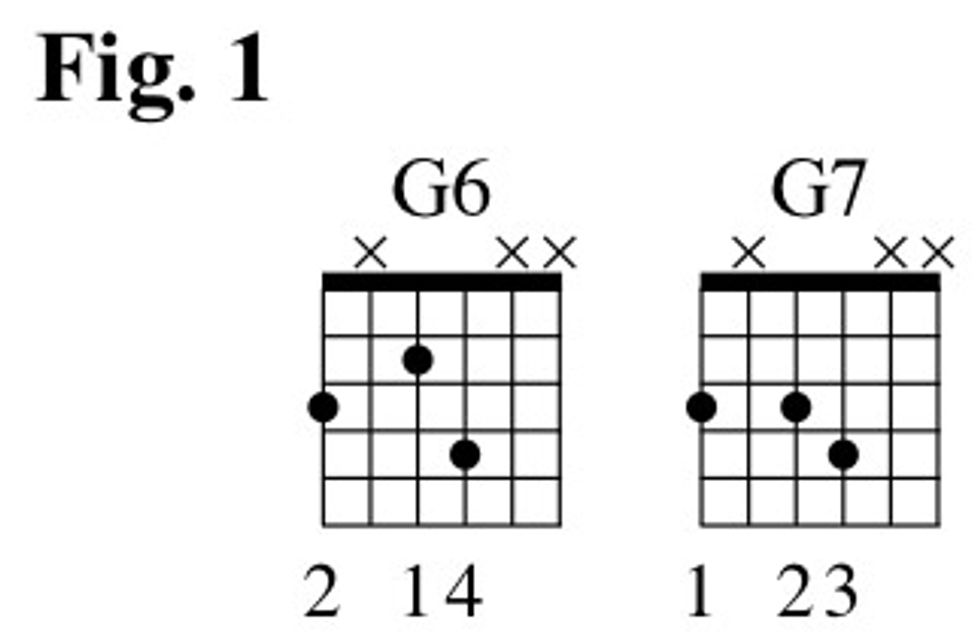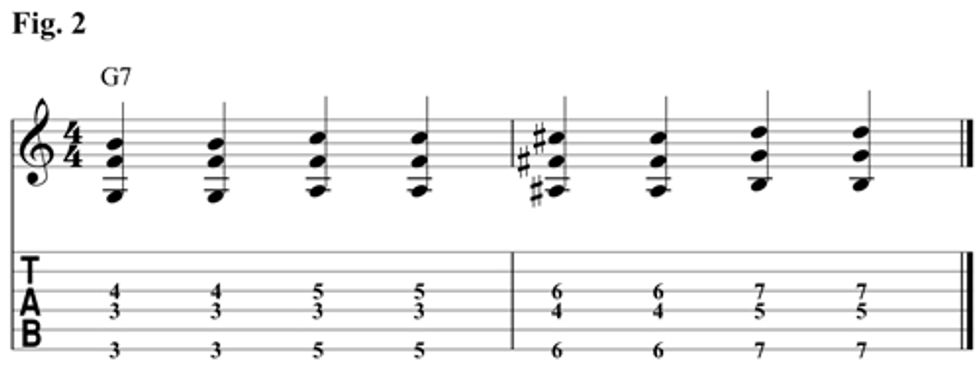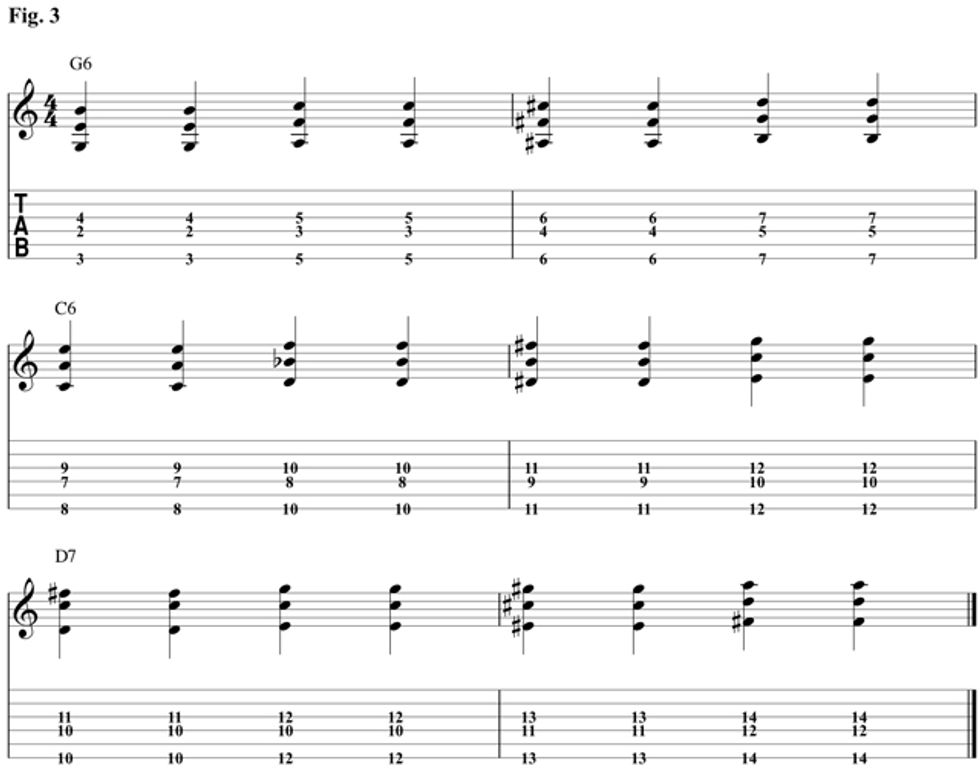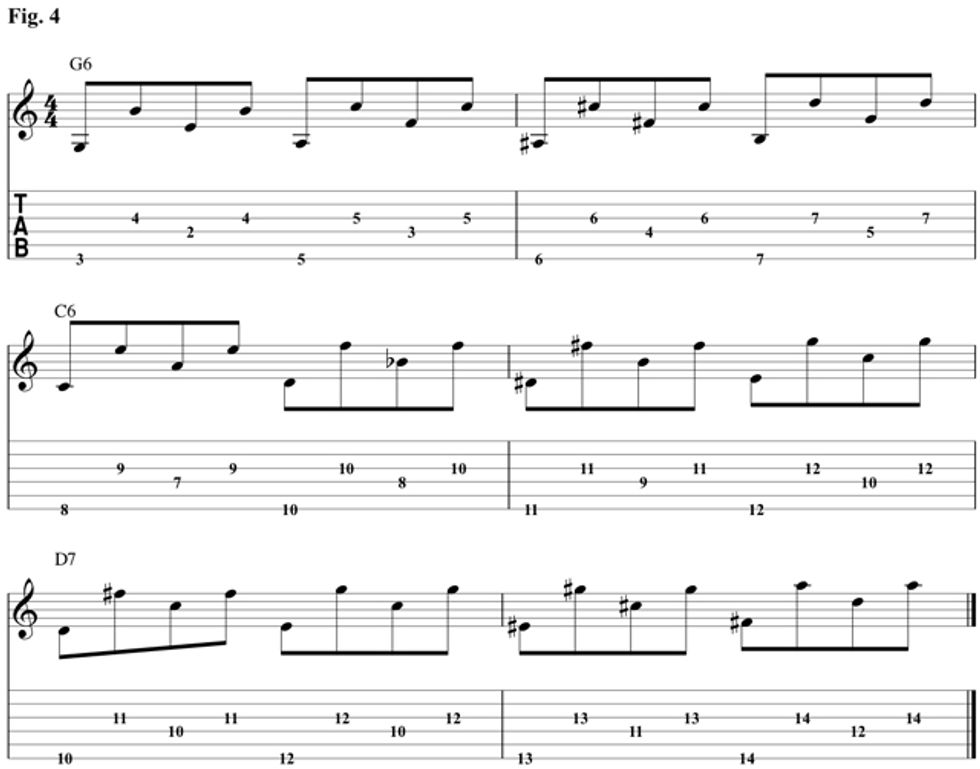Theory: Intermediate
Lesson Overview:
• Understand the basic elements of playing in the style of Freddie Green.
• Learn how to play three-note major and dominant chord voicings.
• Apply these shapes to different styles such as Gypsy jazz and rockabilly.
Click here to download a printable PDF of this lesson's notation and MP3 examples.
This is my first offering in my lesson series called Orange Guitar. I thought I’d demonstrate an idea that is easy, but sounds evolved. My favorite! I’ve used these chord shapes in every musical style imaginable, and they continue to be the staple of rhythmic swing-based playing. Let’s call it the “Freddie Green Walk-Up.” I’ve employed this chord sequence as a musical and versatile approach to embellishing the potentially mundane sound of a one-chord vamp. Best of all, it’s easy and I think it sounds great.
First, let’s learn the first two starting chords shown in Fig. 1, G7 and G6. One important thing—make sure your fingers approach the chord at an angle or a slant. This will mute all the open strings without any effort or thought. If angling your hand is uncomfortable then make sure the guitar is not parallel with your body. The guitar neck should be pointing out a bit from your body. The plus side is your fretting arm has more room to move and is more relaxed. The minus might be losing some visual access to the fretboard. But give it a try, as this allows for a relaxed strumming technique you might not attain holding the back of the guitar firmly against your chest. Now that we are comfortable with G7 and G6, let’s learn the walk-up. You can start with either G6 or G7, depending on genre and mood. For a more "bluesy" feel use G7; for a more major sound, use G6.
You can see in Fig. 2 how the walk-up works over two measures of G7. We take the shape that appears on beat 2 of the first measure and move it up chromatically. Now, let’s transpose the walk-up from G6 to C6, and then D7 as shown in Fig. 3. Again, it helps to angle your fretting hand so it naturally and easily mutes all the unwanted open strings.
Remember, you can create many tonal variations through the placement of your picking hand. Notice that when you pick in the center of the guitar (above the soundhole on a standard acoustic), you create a rounder, mellower sound than if you pick by the bridge, where the sound becomes thinner and more metallic. Repositioning your picking hand is a technique that can be used to create dynamics and drastic changes in tone.
Next, here are some approaches for the walk-up that allow for genre hopping. The first is a Django-style swing feel using G6, C6, and D7 walk-ups. The strumming hand moves from your collarbone to your belt—it’s a large strum that might feel ostentatious or unnecessary. But it is necessary. Using a big motion, you can get a strong rhythmic punch that can drive a groove like a drummer.
Incidentally, this kind of rhythm style is based in the 4-string plectrum banjo, and it’s precedent comes from jazz-guitar pioneers like Eddie Lang and Carl Kress. For an overview of this era, I recommend the album Pioneers of Jazz Guitar, which features guitar greats Eddie Lang, Carl Kress, Lonnie Johnson, and more. This wonderfully satisfying era is where amplification and recording methods allowed players to put down their banjos and play the more dynamic 6-string guitar. In my opinion, this is a “must have” CD that anyone can enjoy.
Last but not least, let’s take an extreme genre hop and use the Freddie Green walk-up in Fig. 4—which might be how the great Merle Travis might have played it. Be sure you start slow and build up to a rapid-fire machine gun of peace-loving music. Attack the 6th string with a flatpick, the 3rd string with the middle finger, then the 4th string with the pick, and finish by striking the 3rd string with the middle finger.
You can use this when playing solo guitar or as a Scotty Moore-style rockabilly pattern. Again, start slow and adhere to the specific picking pattern I’ve suggested. If you take the extra five minutes to play it correctly, you’ll play it great the rest of your life!
 Billboard calls Jim Campilongo “an American treasure." He spins a musical web that ranges from gorgeous to sinister, and in 2011 the Fender Custom Shop released his signature model Telecaster. His band with Norah Jones, the Little Willies, released For the Good Times in early 2012 on Blue Note. For more info and downloadable lessons that cover blues, country, jazz, and more, visit jimcampilongo.com/lessons.
Billboard calls Jim Campilongo “an American treasure." He spins a musical web that ranges from gorgeous to sinister, and in 2011 the Fender Custom Shop released his signature model Telecaster. His band with Norah Jones, the Little Willies, released For the Good Times in early 2012 on Blue Note. For more info and downloadable lessons that cover blues, country, jazz, and more, visit jimcampilongo.com/lessons.













![Rig Rundown: Russian Circles’ Mike Sullivan [2025]](https://www.premierguitar.com/media-library/youtube.jpg?id=62303631&width=1245&height=700&quality=70&coordinates=0%2C0%2C0%2C0)














